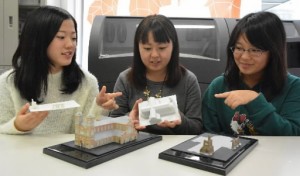College students in Hiroshima create 3D printer models of former Nagasaki cathedral before and after A-bombing
Jan. 5, 2016
by Masahiro Yanagimoto, Staff Writer
Three third-year students at Yasuda Women’s University in Asaminami Ward, Hiroshima have used a 3D printer to create models of the former Urakami Cathedral in Nagasaki, which collapsed as a result of the atomic bombing of that city. The students made two models which depict the cathedral before the bombing and after the building fell. They gave the models to Urakami Cathedral with the hope that their work can be used to appeal for a peaceful world.
Both models are made of plaster and are about one-200th the size of the real cathedral. The model of the old cathedral, before it collapsed, is about 10 centimeters in height while the other model, about 5 centimeters high, shows the state of the building after the bombing, with only crumbling walls left behind. Saki Tamura, 21, Sayaka Harada, 20, and Manami Yano, 20, who have been part of a seminar taught by Shinichi Someoka, 57, a professor in the Faculty of Current Business, have been working on the models since this past August.
The current Urakami Cathedral building was constructed to replace the former cathedral in 1959. The students estimated the size and color of the old cathedral building by using photos and picture postcards, and visited the cathedral in person in September to gather more information. They donated a total of four models including one made of plastic, which is about one-300th the size of the actual building. The cathedral is displaying their models in a drawing room of the priest’s house near the cathedral.
Professor Someoka and his students have also created a model of the A-bomb Dome in Naka Ward, Hiroshima using a 3D printer. The data for making the plastic cathedral model was made available online in September, enabling anyone to reproduce the model with an available 3D printer. Ms. Harada said, “We would like people to feel how destructive and tragic the atomic bomb was by comparing the cathedral models before and after the collapse in three dimensions.”
(Originally published on December 23, 2015)
Three third-year students at Yasuda Women’s University in Asaminami Ward, Hiroshima have used a 3D printer to create models of the former Urakami Cathedral in Nagasaki, which collapsed as a result of the atomic bombing of that city. The students made two models which depict the cathedral before the bombing and after the building fell. They gave the models to Urakami Cathedral with the hope that their work can be used to appeal for a peaceful world.
Both models are made of plaster and are about one-200th the size of the real cathedral. The model of the old cathedral, before it collapsed, is about 10 centimeters in height while the other model, about 5 centimeters high, shows the state of the building after the bombing, with only crumbling walls left behind. Saki Tamura, 21, Sayaka Harada, 20, and Manami Yano, 20, who have been part of a seminar taught by Shinichi Someoka, 57, a professor in the Faculty of Current Business, have been working on the models since this past August.
The current Urakami Cathedral building was constructed to replace the former cathedral in 1959. The students estimated the size and color of the old cathedral building by using photos and picture postcards, and visited the cathedral in person in September to gather more information. They donated a total of four models including one made of plastic, which is about one-300th the size of the actual building. The cathedral is displaying their models in a drawing room of the priest’s house near the cathedral.
Professor Someoka and his students have also created a model of the A-bomb Dome in Naka Ward, Hiroshima using a 3D printer. The data for making the plastic cathedral model was made available online in September, enabling anyone to reproduce the model with an available 3D printer. Ms. Harada said, “We would like people to feel how destructive and tragic the atomic bomb was by comparing the cathedral models before and after the collapse in three dimensions.”
(Originally published on December 23, 2015)








